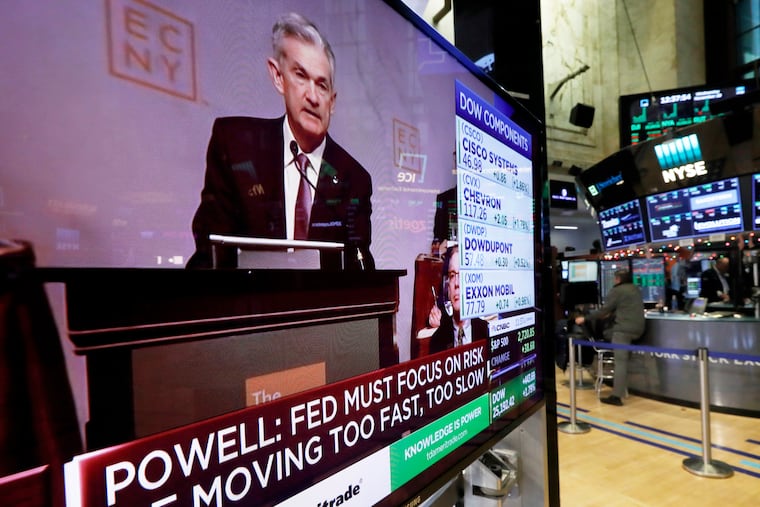High earners complicate Powell’s job | Opinion
The upper and middle class have a more negative view on the economy than the lower class.

If data dependency is the name of the game, then Federal Reserve Chairman Jerome Powell has his work cut out for him. In an economy driven by consumption, the key is having a firm grasp on how spending is poised to perform in the future. The effects of monetary policy play out with a lag of around one year, which suggests any emerging weakness could be exacerbated by the tightening that’s already taken place.
The challenge posed to policy makers in the current environment is the deafening noise in the data. By some measures, spending trends are at multiyear highs. Forward-looking indicators and anecdotal evidence, however, suggest a hard stop is in the offing.
It all comes down to who in the economy is on the receiving end of what. Lower-income earners have been buttressed by rising minimum wages and tax cuts. At the opposite end of the spectrum, high-income earners started 2018 by being rudely shaken out of last year’s state of Nirvana in financial markets. Those stuck in the middle are the most discomfited. They haven't benefited enough from the tax cuts to see a meaningful difference in their household budgets, and they’ve also had to watch their 401(k) balances yo-yo with the markets’ machinations.
This is a problem because the top third of income earners account for 54 percent of consumption while those in the middle contribute 29 percent and the lower-income tier make up the final 17 percent. What this means is that the economy stutters to a halt if the middle and upper-earners ratchet back their spending.
Put another way, households with the most purchasing power are more pessimistic than those with the least purchasing power, which is a rare occurrence. It happened in the aftermath of the recession that officially ended in March 1991, but felt as if it had no end as the unemployment rate continued to rise to almost 8 percent by June 1992. It happened again in 2008-09 following the collapse of Lehman Brothers. There were recurrences after the U.S. lost its AAA credit rating in August 2011 and during the euro crisis that spanned 2011 and 2012.
The current episode is against the backdrop of simmering trade-war tensions between the two biggest economies in the world, the U.S. and China, and a Fed that’s still in tightening mode. These scarcely seen conditions have historically played out in a distinct way in the stock market. With the exception of April 2009, optimism among those who spend the bulk of their marginal income gives discretionary stocks an advantage over consumer staples. Mid-tier car manufacturers and retailers are the primary beneficiaries while companies that produce necessities tend to be the laggards.
At the opposite end of the spectrum, stocks that key off strength at the high end have fallen victim to the relatively dour outlook of middle- and upper-income earners. To take but one example, shares of Sotheby’s are off by more than a third from the all-time high earlier this year. Meanwhile, shares in BlackRock, the world’s largest money manager, are off their lows for the year on recent signs the Fed may pause its rate-hiking cycle.
The challenge for Powell and his colleagues at the central bank is making sense of what’s to come. The shelf life of the U.S.-China trade-war détente is unknown. The global economic slowdown continues to spread like a bad virus, which has manifested in the recent drop in oil prices.
That same decline in oil prices will, however, lead to continued exuberance among the lowest income earners who are the most sensitive to prices at the pump. That could render the upcoming string of retail sales data all the more misleading. Moreover, though nowhere near as strong as the impetus from the 600,000 cars replaced in the aftermath of 2017’s hurricanes, the estimated 45,000 cars lost to Hurricanes Florence and Michael will also introduce a distinct form of noise to the data.
Perhaps the best the Fed can do is follow the housing market rather than retail sales to get a feel for where the economy is headed. The most recent pending home sales report put the tracking index at the lowest level since the summer of 2014. This coincides with the softness in furniture sales that emerged this spring.
As for what’s at the forefront of housing’s infirmity, that would be luxury homes where inventory is amassing at a faster pace. The risk posed by continued pessimism among those responsible for 83 percent of consumption should be front and center for Powell. Key data points due out in coming days and weeks should clarify the outlook. In the meantime, the national day of mourning that postponed Powell’s Wednesday appearance before Congress is no doubt a welcome reprieve as he prepares to defend or deny his dovish pivot at the New York Economics Club last week.